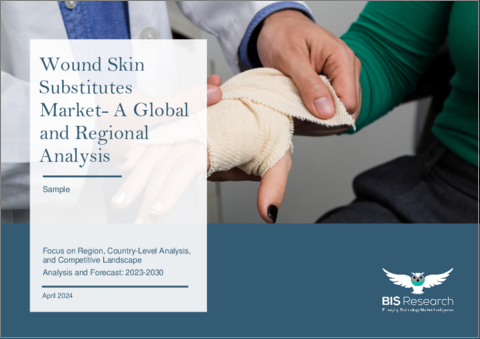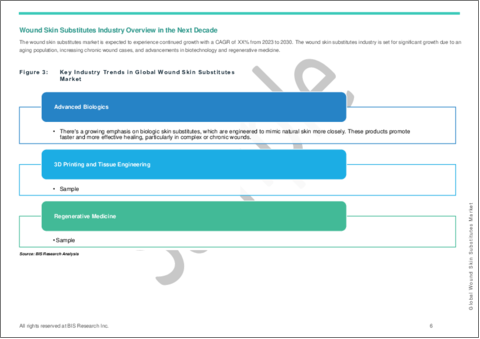|
|
市場調査レポート
商品コード
1488258
創傷用代用皮膚市場 - 世界および地域の分析:地域・国別分析・競合情勢・分析と予測 (2023~2030年)Wound Skin Substitutes Market - A Global and Regional Analysis: Focus on Region, Country-Level Analysis, and Competitive Landscape - Analysis and Forecast, 2023-2030 |
||||||
カスタマイズ可能
|
|||||||
| 創傷用代用皮膚市場 - 世界および地域の分析:地域・国別分析・競合情勢・分析と予測 (2023~2030年) |
|
出版日: 2024年06月04日
発行: BIS Research
ページ情報: 英文 41 Pages
納期: 1~5営業日
|
- 全表示
- 概要
- 図表
- 目次
世界の創傷用代用皮膚の市場規模は、2022年の11億8,100万米ドルから、2023年から2030年にかけての予測期間中はCAGR 7.35%で堅調に推移し、2030年には20億6,260万米ドルに達すると予測されています。
糖尿病性足潰瘍、褥瘡、静脈性下腿潰瘍などの慢性創傷の増加により、革新的で効果的な創傷治癒ソリューションへの需要が急増しています。
| 主要市場統計 | |
|---|---|
| 予測期間 | 2023-2030年 |
| 2023年評価 | 12億5,550万米ドル |
| 2030年予測 | 20億6,260万米ドル |
| CAGR | 7.35% |
生体材料の技術的進歩と、より効率的な皮膚代替製品の開発が、この成長をさらに促進しています。また、慢性疾患に罹患しやすい高齢者人口の増加や、世界の医療インフラの機能拡大も、市場拡大に大きく寄与しています。さらに、患者の転帰を改善し、慢性創傷に関連する全体的な医療コストを削減することへの注目が高まっていることも、この成長を支えています。
世界市場においては北米地域が支配的であり、2022年には78.12%のシェアを示しました。この大きなシェアは、人口の高齢化、糖尿病と相関性の高い肥満の急増、放射線治療の晩期障害など、いくつかの要因によるものです。これらの要因は、患者による創傷用代用皮膚の採用をさらに後押しし、収益成長につながっています。アジア太平洋、欧州、ラテンアメリカ地域も、慢性創傷の発生率の急増、革新的な製品の開発につながる技術の進歩、医療費の増加により、大きな成長が見込まれています。
参入企業:
- Coloplast
- Smith & Nephew
- MTF Biologics
- MiMedx Group, Inc
- AlloSource
- Organogenesis Inc.
- RTI Surgical
- LifeNet Health
- Molecular Biologicals, Inc
当レポートでは、世界の創傷用代用皮膚の市場を調査し、市場概要、市場規模の推移・予測、地域/主要国別の詳細分析、競合情勢、主要企業のプロファイルなどをまとめています。
目次
エグゼクティブサマリー
第1章 市場
第2章 地域
- 地域別概要
- 北米
- 米国
- カナダ
- 欧州
- ドイツ
- 英国
- フランス
- イタリア
- スペイン
- トルコ
- オランダ
- ロシア
- スイス
- ポーランド
- オーストリア
- チェコ共和国
- スウェーデン
- ルーマニア
- アイルランド
- ベルギー
- ギリシャ
- ポルトガル
- ノルウェー
- スロバキア
- デンマーク
- ウクライナ
- フィンランド
- アジア太平洋
- 中国
- 日本
- インド
- 韓国
- オーストラリア
- タイ
- マレーシア
- ラテンアメリカ
- ブラジル
- メキシコ
- アルゼンチン
- コロンビア
- チリ
- その他の地域
第3章 市場:競合ベンチマーキング
- 主な戦略・展開
- 主要企業エコシステム
第4章 調査手法
List of Figures
- Figure 1: Global Wound Skin Substitutes Market, $Million, 2022, 2026, and 2030
- Figure 2: Global Wound Skin Substitutes Market (by Region), $Million, 2022, 2026, and 2030
- Figure 3: Key Industry Trends in Global Wound Skin Substitutes Market
- Figure 4: U.S. Wound Skin Substitutes Market, $Million, 2021-2030
- Figure 5: Canada Wound Skin Substitutes Market, $Million, 2021-2030
- Figure 6: Germany Wound Skin Substitutes Market, $Million, 2021-2030
- Figure 7: U.K. Wound Skin Substitutes Market, $Million, 2021-2030
- Figure 8: France Wound Skin Substitutes Market, $Million, 2021-2030
- Figure 9: Italy Wound Skin Substitutes Market, $Million, 2021-2030
- Figure 10: Spain Wound Skin Substitutes Market, $Million, 2021-2030
- Figure 11: Turkey Wound Skin Substitutes Market, $Million, 2021-2030
- Figure 12: Netherlands Wound Skin Substitutes Market, $Million, 2021-2030
- Figure 13: Russian Federation Wound Skin Substitutes Market, $Million, 2021-2030
- Figure 14: Switzerland Wound Skin Substitutes Market, $Million, 2021-2030
- Figure 15: Poland Wound Skin Substitutes Market, $Million, 2021-2030
- Figure 16: Austria Wound Skin Substitutes Market, $Million, 2021-2030
- Figure 17: Czech Republic Wound Skin Substitutes Market, $Million, 2021-2030
- Figure 18: Sweden Wound Skin Substitutes Market, $Million, 2021-2030
- Figure 19: Romania Wound Skin Substitutes Market, $Million, 2021-2030
- Figure 20: Ireland Wound Skin Substitutes Market, $Million, 2021-2030
- Figure 21: Belgium Wound Skin Substitutes Market, $Million, 2021-2030
- Figure 22: Greece Wound Skin Substitutes Market, $Million, 2021-2030
- Figure 23: Portugal Wound Skin Substitutes Market, $Million, 2021-2030
- Figure 24: Norway Wound Skin Substitutes Market, $Million, 2021-2030
- Figure 25: Slovakia Wound Skin Substitutes Market, $Million, 2021-2030
- Figure 26: Denmark Wound Skin Substitutes Market, $Million, 2021-2030
- Figure 27: Ukraine Wound Skin Substitutes Market, $Million, 2021-2030
- Figure 28: Finland Wound Skin Substitutes Market, $Million, 2021-2030
- Figure 29: China Wound Skin Substitutes Market, $Million, 2021-2030
- Figure 30: Japan Wound Skin Substitutes Market, $Million, 2021-2030
- Figure 31: India Wound Skin Substitutes Market, $Million, 2021-2030
- Figure 32: South Korea Wound Skin Substitutes Market, $Million, 2021-2030
- Figure 33: Australia Wound Skin Substitutes Market, $Million, 2021-2030
- Figure 34: Thailand Wound Skin Substitutes Market, $Million, 2021-2030
- Figure 35: Malaysia Wound Skin Substitutes Market, $Million, 2021-2030
- Figure 36: Brazil Wound Skin Substitutes Market, $Million, 2021-2030
- Figure 37: Mexico Wound Skin Substitutes Market, $Million, 2021-2030
- Figure 38: Argentina Wound Skin Substitutes Market, $Million, 2021-2030
- Figure 39: Colombia Wound Skin Substitutes Market, $Million, 2021-2030
- Figure 40: Chile Wound Skin Substitutes Market, $Million, 2021-2030
- Figure 41: Data Triangulation
- Figure 42: Top-Down and Bottom-Up Approach
- Figure 43: Assumptions and Limitations
List of Tables
- Table 1: Market Snapshot
- Table 2: Global Wound Skin Substitutes Market, Opportunities
- Table 3: Global Wound Skin Substitutes Market (by Region), $Million, 2021-2030
- Table 4: North America Wound Skin Substitutes Market (by Country), $Million, 2021-2030
- Table 5: Europe Wound Skin Substitutes Market (by Country), $Million, 2021-2030
- Table 6: Asia-Pacific Wound Skin Substitutes Market (by Country), $Million, 2021-2030
- Table 7: Latin America Wound Skin Substitutes Market (by Country), $Million, 2021-2030
- Table 8: Rest-of-the-World Wound Skin Substitutes Market (by Country), $Million, 2021-2030
- Table 9: Key Initiatives, 2021-2024
- Table 10: Key Companies, Global Wound Skin Substitutes Market
Introduction of Wound Skin Substitutes
The global wound skin substitutes market, valued at $1,181.0 million in 2022, is on a robust growth trajectory and is anticipated to reach $2,062.6 million by 2030. This market is expected to expand at a compound annual growth rate (CAGR) of 7.35% between 2023 and 2030. Driven by the increasing prevalence of chronic wounds such as diabetic foot ulcers, pressure ulcers, and venous leg ulcers, the market is witnessing a surge in demand for innovative and effective wound healing solutions.
Market Introduction
| KEY MARKET STATISTICS | |
|---|---|
| Forecast Period | 2023 - 2030 |
| 2023 Evaluation | $1,255.5 Million |
| 2030 Forecast | $2,062.6 Million |
| CAGR | 7.35% |
Technological advancements in biomaterials and the development of more efficient skin substitute products are further fueling this growth. Moreover, the rising geriatric population, which is more prone to chronic conditions, and the expanding capabilities of healthcare infrastructures globally are significant contributors to the market's expansion. This growth has also been supported by a growing focus on improving patient outcomes and reducing the overall healthcare costs associated with chronic wounds.
Regional Segmentation:
- North America
- U.S.
- Canada
- Europe
- U.K.
- Germany
- France
- Italy
- Spain
- Netherlands
- Switzerland
- Russian Federation
- Turkey
- Poland
- Belgium
- Sweden
- Ireland
- Norway
- Austria
- Denmark
- Finland
- Portugal
- Czech Republic
- Romania
- Greece
- Slovakia
- Ukraine
- Asia-Pacific
- Japan
- China
- India
- South Korea
- Australia
- Malaysia
- Thailand
- Latin America
- Brazil
- Mexico
- Colombia
- Argentina
- Chile
- Rest-of-the-World
The global wound skin substitutes market has been dominated by North America, which held a 78.12% share in 2022. This significant share can be attributed to several factors, including an aging population, the steep rise in the prevalence of obesity that is heavily correlated to diabetes, and the late effects of radiation therapies. These factors have further boosted the adoption of wound skin substitutes among patients, thereby boosting revenue growth. Asia-Pacific, Europe, and Latin America regions are expected to witness significant growth in the wound skin substitutes market due to a surge in the incidence rate of chronic wounds, technological advancements leading to the development of innovative products, and increasing healthcare expenditure.
Recent Developments in the Wound Skin Substitutes Market
- In July 2023, Coloplast announced an agreement to acquire Kerecis for up to $1.3 billion. Kerecis has pioneered patented technology for treating wounds and burns by utilizing unaltered fish skin.
- In April 2023, Coloplast (Kerecis) announced MariGen Shield, which integrates the company's proven fish-skin graft with a silicone contact layer for treating chronic and complex wounds.
- In January 2023, Coloplast (Kerecis) announced the release of two new products for the burn market, GraftGuide Mano and GraftGuide Micro. This latest innovation is a specialized fish skin product tailored for treating burns specifically on the hand.
- In January 2022, Researchers from the University of Birmingham and the University of Huddersfield, UK, developed a new 3D bioprinting technique that could be used to treat chronic wounds.
- In October 2021, Coloplast (Kerecis) received authorization from the FDA to market Kerecis Omega3 SurgiBind. This implant is a fish-skin graft that can be implanted for plastic and reconstructive surgical procedures.
How can this report add value to an organization?
Product/Innovation Strategy: By understanding specific regional needs and preferences highlighted in the report, a company can tailor its product development to address local market demands effectively. This might include innovation in skin substitute materials that cater to prevalent wound types in a particular region.
Growth/Marketing Strategy: With detailed regional data, companies can craft precise marketing strategies that resonate with local healthcare providers and patients. This includes choosing the right channels and messages that appeal to the specific demographic and economic conditions of the region.
Competitive Strategy: The report provides an analysis of key competitors in the region, allowing companies to benchmark their products and strategies. Knowing the competitive landscape helps in positioning their offerings more effectively to capture market share.
Methodology
Key Considerations and Assumptions in Market Engineering and Validation
- The base year considered for the calculation of the market size is 2022. A historical year analysis has been done for the period FY2019-FY2021. The market size has been estimated for FY2022 and projected for the period FY2023-FY2030.
- The scope of this report has been carefully derived based on interactions with experts in different companies worldwide. This report provides a market study of upstream and downstream products of wound skin substitutes.
- The market contribution of wound skin substitutes anticipated to be launched in the future has been calculated based on the historical analysis of the solutions.
- Revenues of the companies have been referenced from their annual reports for FY2022 and FY2023. For private companies, revenues have been estimated based on factors such as inputs obtained from primary research, funding history, market collaborations, and operational history.
- The market has been mapped based on the available wound skin substitute solutions. This report has considered and profiled all the key companies with significant offerings in this field.
Primary Research:
The primary sources involve industry experts in wound skin substitutes, including the market players offering products and services. Resources such as CEOs, vice presidents, marketing directors, and salespersons have been interviewed to obtain and verify both qualitative and quantitative aspects of this research study.
The key data points taken from the primary sources include:
- Validation and triangulation of all the numbers and graphs
- Validation of the report's segmentation and key qualitative findings
- Understanding the competitive landscape and business model
- Current and proposed production values of a product by market players
- Percentage split of individual markets for regional analysis
Secondary Research
Open Sources
- Certified publications, articles from recognized authors, white papers, directories, and major databases, among others
- Annual reports, SEC filings, and investor presentations of the leading market players
- Company websites and detailed study of their product portfolio
- Gold standard magazines, journals, white papers, press releases, and news articles
- Paid databases
The key data points taken from the secondary sources include:
- Segmentations and percentage shares
- Data for market value
- Key industry trends of the top players of the market
- Qualitative insights into various aspects of the market, key trends, and emerging areas of innovation
- Quantitative data for mathematical and statistical calculations
Key Market Players and Competition Synopsis
The competitive landscape of the wound skin substitutes market has been characterized by the presence of several key players, each offering a range of specialized products. Coloplast, for instance, has made significant strides with products such as MariGen Shield, GraftGuide Mano, and GraftGuide Micro, which are tailored to address various aspects of wound care, particularly burns and complex wounds. The companies are not only innovating in product development but also expanding their market reach and setting industry standards in the treatment of complex wounds. This dynamic competitive environment underscores the continuous evolution and technological advancement within the wound care industry.
Some prominent names established in this market are:
- Coloplast
- Smith & Nephew
- MTF Biologics
- MiMedx Group, Inc
- AlloSource
- Organogenesis Inc.
- RTI Surgical
- LifeNet Health
- Molecular Biologicals, Inc
Table of Contents
Executive Summary
1 Market
- 1.1 Product Definition
- 1.2 Inclusion and Exclusion Criteria
- 1.2.1 Inclusion
- 1.2.2 Exclusion Criteria
- 1.3 Key Questions Answered
- 1.4 Analysis and Forecast Note
- 1.5 Key Findings
2 Regions
- 2.1 Regional Summary
- 2.2 North America
- 2.2.1 U.S.
- 2.2.2 Canada
- 2.3 Europe
- 2.3.1 Germany
- 2.3.2 U.K.
- 2.3.3 France
- 2.3.4 Italy
- 2.3.5 Spain
- 2.3.6 Turkey
- 2.3.7 Netherlands
- 2.3.8 Russian Federation
- 2.3.9 Switzerland
- 2.3.10 Poland
- 2.3.11 Austria
- 2.3.12 Czech Republic
- 2.3.13 Sweden
- 2.3.14 Romania
- 2.3.15 Ireland
- 2.3.16 Belgium
- 2.3.17 Greece
- 2.3.18 Portugal
- 2.3.19 Norway
- 2.3.20 Slovakia
- 2.3.21 Denmark
- 2.3.22 Ukraine
- 2.3.23 Finland
- 2.4 Asia-Pacific
- 2.4.1 China
- 2.4.2 Japan
- 2.4.3 India
- 2.4.4 South Korea
- 2.4.5 Australia
- 2.4.6 Thailand
- 2.4.7 Malaysia
- 2.5 Latin America
- 2.5.1 Brazil
- 2.5.2 Mexico
- 2.5.3 Argentina
- 2.5.4 Colombia
- 2.5.5 Chile
- 2.6 Rest-of-the-World
3 Markets - Competitive Benchmarking
- 3.1 Key Strategies and Developments
- 3.2 Key Companies Ecosystem
4 Research Methodology
- 4.1 Data Sources
- 4.1.1 Primary Data Sources
- 4.1.2 Secondary Data Sources
- 4.1.3 Data Triangulation
- 4.2 Market Estimation and Forecast






